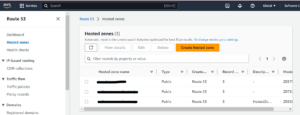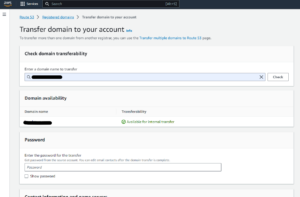Thinking about unlocking the powerful integration of AWS services for your WordPress site, ReactJS/NodeJS, or Laravel web app? Domain transfer to AWS route53 or between any other registrar could be a mandatory first step. Having your existing domain transferred and registered in AWS route53 makes connecting to services like AWS LightSail, AWS lambda microservices or AWS ECS or EKS much simpler too. Whether you’re an ambitious startup founder, a hands-on devops engineer, or a forward-thinking technical project manager, the journey often starts with transferring your existing domain name. Hence where better to manage it than AWS Route53, Amazon’s scalable and secure domain name system (DNS) web service? Therefore, if you’re switching from popular hosts like Godaddy.com, a2hosting.com, Namecheap.com or Name.com, this guide is tailored for you.
Domain transfer – what does it mean?
It simply is the transfer of a domain from one registrar to another of your choice.1. Get Started with AWS Console:
First things first: Sign up for an AWS account if you haven’t yet. Existing users, log into your AWS Management Console. In a hurry? jump to the section on transferring in a domain to AWS Route53 here.
2. Dive into Route53 and create a new hosted zone:
In the AWS dashboard, locate and click on the Route53 service. Create your new hosted zone and jot down the four nameservers provided.

3. Safeguard Your Current DNS Records:
As you move forward, ensure you have a safety net. Thoroughly document or back up all DNS records from your existing domain registrar, capturing A, MX, CNAME, TXT, and other vital records. Replicating MX records are key for your email service such as Google Apps to continue working.

4. Mirror DNS Records in Route53:
With your records in hand, replicate them within the Route53 hosted zone. These records are essential for continuity, especially for maintaining your email service.
5. Patiently Await DNS Propagation:
DNS changes, while often swift on AWS, can take some time across the global servers. Allow some hours for the DNS changes to propagate fully.
6. Update Your Nameservers:
Revisit your current domain registrar platform, whether it’s Godaddy.com, Name.com, or another. Here, replace the old nameservers with the set provided by Route53.
7. Vigilantly Monitor the Transition:
Using DNS tools such as dig, nslookup, or platforms like whatsmydns.net, you can track the DNS propagation. This step ensures that your web traffic smoothly flows to your AWS infrastructure.
8. Comprehensive Website and Email Testing:
Consistency is key. Regularly access your site across various devices and networks. Also, conduct email tests, both sending and receiving, to validate uninterrupted service.
9. Secure Your Route53 Configuration:
In the digital age, always backup! Use AWS’s tools to backup your DNS configurations, safeguarding against unforeseen disruptions.
10. Generate the transfer token from the old registrar and use it to authorize the domain transfer
You can generate a transfer authorization code from the old registrar and use it in AWS Route 53 to import the domain name. You can select the “Transfer in” option from the Domains console inside Route 53 to start this process. Sometimes you might first need to unlock the domain before a transfer token can be generated from your old registrar. Read here for more instructions and look up related costs if any.

11. Harness the Power of AWS Integration:
With your domain now on Route53, seamlessly integrate top-tier AWS services, whether it’s AWS Lightsail for WordPress, the efficiency of AWS Lambda microservices, or the robust offerings of AWS ECS or EKS. Adjust any configurations as needed.
12. Concluding Steps at the Previous Registrar (Optional):
Once settled in the AWS ecosystem and assured of its functionality, consider pausing DNS-related services at your former registrar. But, importantly, keep the domain registration alive.
Final Thoughts:
Migrating your domain to AWS Route53 can appear challenging. Yet, with this comprehensive guide, you’re equipped for a hassle-free transition. Always prioritize monitoring and thorough testing to guarantee a top-notch experience for your audience and seamless business operations. Dive in and unlock the AWS ecosystem’s potential today!
Contact us for a free meeting to discuss how you can go about transferring your domain to a new registrar such as AWS Route53 today!